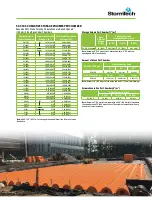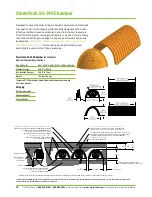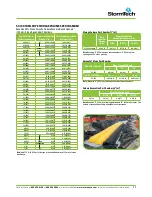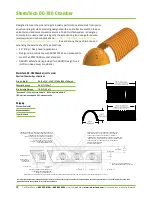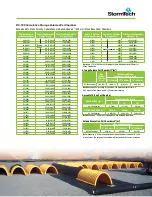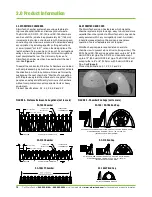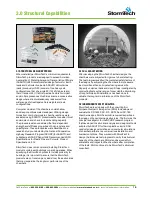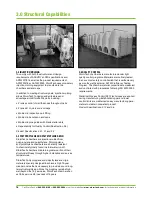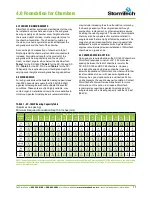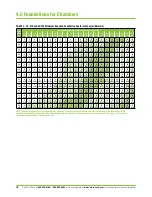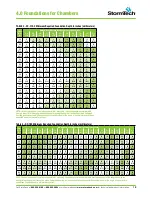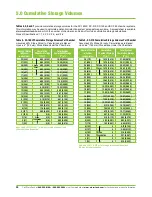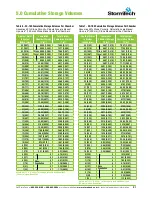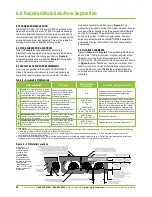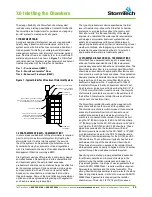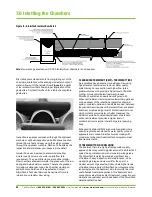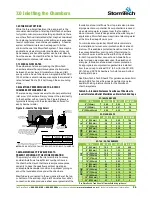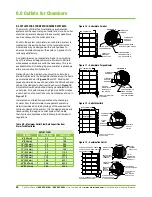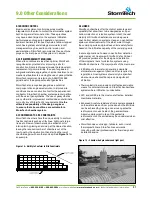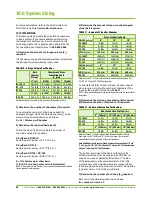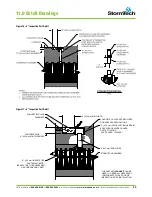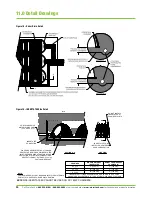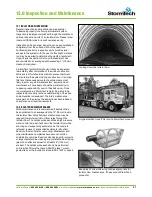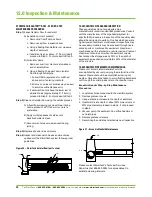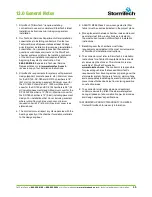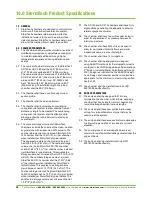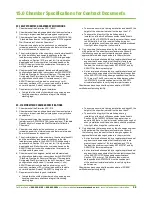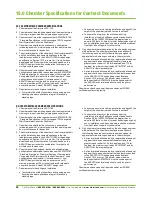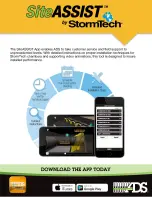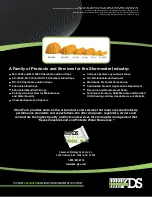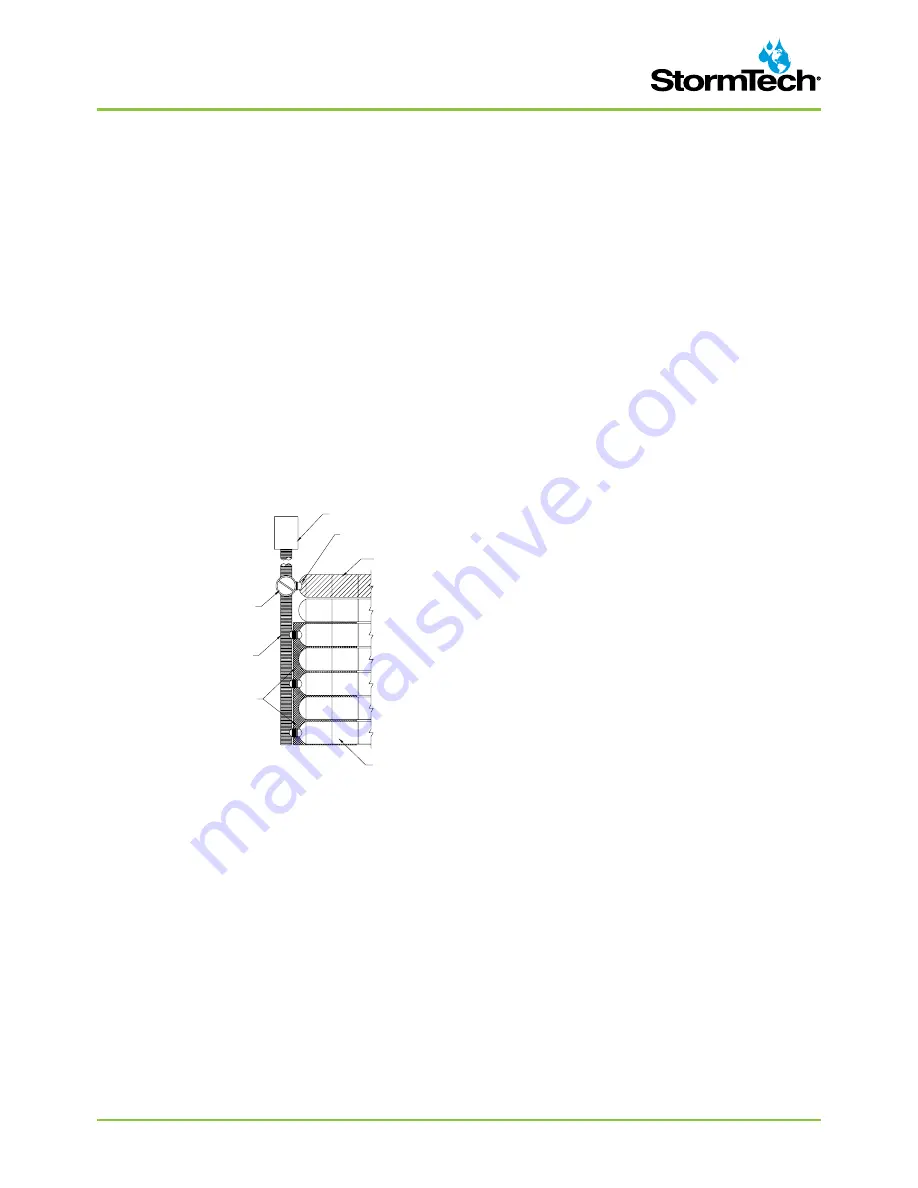
Call StormTech at
860.529.8188
or
888.892.2694
or visit our website at
www.stormtech.com
for technical and product information.
23
7.0 Inletting the Chambers
The design flexibility of a StormTech chamber system
includes many inletting possibilities. Contact StormTech’s
Technical Service Department for guidance on designing
an inlet system to meet specific site goals.
7.1 TREATMENT TRAIN
A properly designed inlet system can ensure good water
quality, easy inspection and maintenance, and a long
system service life. StormTech recommends a treatment
train approach for inletting an underground stormwater
management system under a typical commercial parking
area. Treatment train is an industry term for a multi-tiered
water quality network. As shown in
Figure 7
, a StormTech
recommended inlet system can inexpensively have tiers of
treatment upstream of the StormTech chambers:
Tier 1 – Pre-treatment (BMP)
Tier 2 - StormTech Isolator
®
Row
Tier 3 - Enhanced Treatment (BMP)
7.2 PRE-TREATMENT (BMP) – TREATMENT TIER 1
In some areas pre-treatment of the stormwater is required
prior to entry into a stormwater system. By treating the
stormwater prior to entry into the system, the service
life of the system can be extended, pollutants such as
hydrocarbons may be captured, and local regulations
met. Pre-treatment options are often described as a Best
Management Practice or simply a BMP.
Pre-treatment devices differ greatly in complexity, design
and effectiveness. Depending on a site’s characteristics
and treatment goals, the simple, least expensive
pretreatment solutions can sometimes be just as effective
as the complex systems. Options include a simple deep
sumped manhole with a 90° bend on its outlet, baffle
boxes, swirl concentrators, and devices that combine
these processes. Some of the most effective pretreatment
options combine engineered site grading with vegetation
such as bio-swales or grassy strips.
Figure 7 - Typical StormTech Treatment Train Inlet System
The type of pretreatment device specified as the first
level of treatment up-stream of a StormTech chamber
system can vary greatly throughout the country and
from site-to-site. It is the responsibility of the design
engineer to understand the water quality requirements
and design a stormwater treatment system that will
satisfy local regulators and follow applicable laws. A
design engineer should apply their understanding of local
weather conditions, site topography, local maintenance
requirements, expected service life, etc. to select an
appropriate stormwater pre-treatment system.
7.3 STORMTECH ISOLATOR ROW – TREATMENT TIER 2
StormTech has a patented technique to inexpensively
enhance Total Suspended Solids (TSS) removal and
provide easy access for inspection and maintenance. The
StormTech Isolator Row is a row of standard StormTech
chambers surrounded with appropriate filter fabrics and
connected to a manhole for easy access. This application
basically creates a filter/detention basin that allows water
to egress through the surrounding filter fabric while
sediment is trapped within. It may be best to think of
the Isolator Row as a first-flush treatment device. First-
Flush is a term typically used to describe the first 1/2” to
1” (13-25 mm) of rainfall or runoff on a site. The majority
of stormwater pollutants are carried in the sediments of
the firstflush, therefore the Isolator Row is an effective
component of a treatment train.
The StormTech Isolator Row should be designed with
a manhole with an overflow weir at its upstream end.
The diversion manhole is multi-purposed. It can provide
access to the Isolator Row for both inspection and
maintenance and acts as a diversion structure. The
manhole is connected to the Isolator Row with a short
length of 8” (200mm) pipe for the SC-160LP chambers,
12” (300 mm) pipe for the SC-310 chamber and 24” (600
mm) pipe for the SC-740 and DC-780 chambers. These
pipes are connected to the Isolator Row with an 8”
(200mm) precored end cap for the SC-160LP, a 12” (300
mm) fabricated end cap for the SC-310 chamber and a
24” (600 mm) fabricated end cap for the SC-740 and DC-
780 chambers. The overflow weir typically has its crest
set between the top of the chamber and its midpoint.
This allows storm water in excess of the Isolator Row’s
storage/conveyance capacity to bypass into the chamber
system through the downstream manifold system.
Specifying and installing proper geotextiles is essential
for efficient operation and to prevent damage to the
system during the JetVac maintenance process. In a
typical configuration, two strips of woven geotextile that
meet AASHTO M288 Class 1 requirements are required
between the chambers and the stone foundation. This
strong filter fabric traps sediments and protects the stone
base during maintenance. A strip of non-woven AASHTO
M288 Class 2 geotextile is draped over the Isolator
chamber row. This 6-8 oz. (217-278 g/m2) nonwoven
STRUCTURE WITH OVERFLOW WEIR
(48” (1200 mm) MIN. DIA. WITH 24” (600 mm)
SUMP RECOMMENDED FOR ACCESS)
OVERFLOW MANIFOLD
ADS 315WTM (OR EQUAL) WOVEN
GEOTEXTILE OVER FOUNDATION
STONE FOR SCOUR PROTECTION
AT ALL CHAMBER INLET ROWS
OPTIONAL PRE-TREATMENT
24” (600 mm) DIA. ACCESS
PIPE REQUIRED
STORMTECH
ISOLATOR ROW
STORMTECH
CHAMBERS
Summary of Contents for StormTech DC-780
Page 2: ...An company TOOL 2 0 DESIGN ...
Page 39: ......

